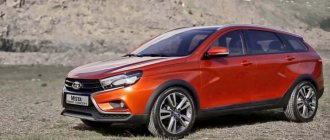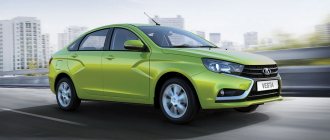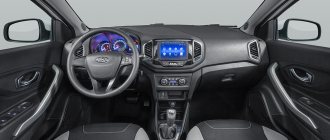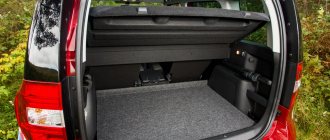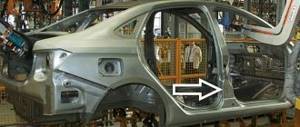The Russian automobile market has recently been replenished with another affordable model. In this case we are talking about the German budget car Volkswagen Polo in the new generation. Now this vehicle will be sold in a liftback body. The recently released new product has already caused numerous discussions among car enthusiasts, since it is literally a new car that can become a leader in its class of budget vehicles. That is why this model is worth comparing with another representative of the budget segment of the Russian assembly, Lada Vesta, in order to ultimately decide which is better - Volkswagen Polo or Lada Vesta.
Lada Vesta 2020
Comparison of technical characteristics
Since many motorists first of all, when choosing a vehicle, pay attention to the main technical characteristics, here it is necessary to highlight the most significant parameters of the presented cars, namely:
- Lada Vesta is sold in a sedan body, the German competitor is sold in a liftback body;
- the domestic model consumes AI-92 fuel, rival AI-95;
- both cars can only be purchased in front-wheel drive versions;
- public sector vehicles are available in petrol versions;
- average fuel consumption in the combined cycle is 6.4 liters. for Polo, 6.9 l. at West;
- Lada's maximum speed is 175 km/h, Volkswagen's is 184 km/h;
- the German accelerates to the first hundred in 11.4 s, the Russian model in 11.2 s;
- The cars belong to the Euro-5 environmental safety class.
In this case, similar cars in the most affordable variations were compared. It is noteworthy that a domestic car can also be purchased with gas equipment, however, such modifications are not particularly in demand.
Motors
In the table below you can see a comparison of engines offered by the manufacturer for motorists.
| Vesta | Vs | Polo (sedan) |
| VAZ-21129: 106hp | VW 1.6 – 85 hp | |
| VAZ-21179: 122hp | VW 1.6 – 110 hp | |
| HR16DE: 110hp |
We recommend: 3 automotive fluids that require special attention
Note that the internal combustion engine from the German concern installed in the Polo has the same displacement (1.6 l), but there are still some differences:
The first modification from the table has 85 hp. at good speed parameters. A car with such an engine accelerates to hundreds in 11.9 seconds. The maximum speed of such a car is 179 km/h.
The second internal combustion engine already contains 110 “horses”. Acceleration time to 100 km/h is 10.5 seconds. The highest achievable speed of this modification is 190 km/h.
The domestic manufacturer offers its customers three modifications of engines with 106, 110 and 122 hp, respectively:
The 1.6L has the lowest-power Vesta engine. A car equipped with such an engine accelerates to hundreds in 12.4 seconds, and the maximum speed of such a car is 178 km/h.
The next unit has 110 “horses” under the hood and allows it to accelerate to 100 km/h in 10.3 seconds. The highest speed achieved is 170 km/h.
The engine with the most powerful efficiency installed in the Russian new product already contains 1.8 liters, has a maximum speed of 185 km/h and allows acceleration to 100 km/h in 10.9 seconds.
Now let's look at the fuel consumption table for both cars:
| Model | Consumption | ||
| City | Mix | Route | |
| Vesta 1.6l-1.8l (106-122 hp) | 8.5l-8.6l | 6.8l-7.2l | 5.7l-5.9l |
| Polo 1.6l (85-110 hp) | 7l-7.6 l | 5.5l-6l | 5l -5.5 l |
Gasoline consumption for both cars is almost identical, with some advantage for the Volkswagen Polo. Also, the domestic new product is a little slower than the German representative, although Vesta’s internal combustion engines have more power.
Engines and transmission
Another key point that potential buyers of a budget car should pay attention to when choosing a Volkswagen Polo or Lada Vesta is the power unit. In this regard, state employees received good equipment, although the German liftback looks more interesting, for the simple reason that there are three alternative engines, as well as three transmissions to choose from depending on the version of the car. For the domestic model, the manufacturer has provided only two main engines and two gearboxes. It can be said directly that in the case of the Lada Vesta, the choice is really meager, despite the fact that this car has been sold on the Russian car market for five years.
The new German model Volkswagen Polo in a liftback body can be purchased with a naturally aspirated 1.6-liter engine with a capacity of 90 and 110 horsepower, depending on the degree of boost. This motor allows you to transmit 155 N*m of torque to the wheels. This power plant can be paired with a 5-speed manual gearbox or a modern 6-speed automatic transmission. There is also a more interesting variation of the car available for sale with a turbocharged 1.4-liter unit with an output of 125 horsepower and 200 Nm of torque. This motor interacts exclusively with a robotic 7-speed DSG gearbox. This model can only be purchased in a front-wheel drive version.
The Russian car did not receive a charged version, unlike its German competitor, and we can safely say that the Lada Vesta is inferior in terms of power, since it uses the already familiar 1.6 and 1.8 liter engines with output of 106 and 122 horsepower and 148 – 170 N*m of torque. As for models equipped with LPG, they are equipped primarily with a 1.6-liter unit producing 113 hp. and a 5-speed manual transmission. Gasoline naturally aspirated modifications of the car are equipped with a 5-speed manual transmission, as well as a 5-speed robot. Some versions of the car use a CVT, although this gearbox has not gained serious distribution and popularity.
Engine characteristics and fuel consumption.
AvtoVAZ currently offers 2 engines of its own production. Their characteristics are approximately the following:
The engine has a power of 106 horsepower, and its volume is 1.6 liters, the speed provided by this engine reaches 178 km h. The engine with the highest power of 122 horsepower and a volume of 1.8 liters is the most powerful engine of the model. The most expensive foreign engine from Nissan-Renault has a volume of 1.6 liters with a power of 114 horsepower - but is still not installed on Vesta. The Polo has two engines of the same volume: 1.6 liters, but both have lower gasoline consumption compared to 2180, which is very pleasant for an economical driver. The first engine has 90 horsepower under the hood, the second has 110, despite the efficiency of gasoline, it successfully reaches speeds of up to 190 km/h.
As a result, the rival from abroad has more advanced engines, and the 1.8 engine of the Vesta is more powerful.
Ride quality, maneuverability and handling
Since many Russian car enthusiasts cannot afford the opportunity to purchase an off-road vehicle, they are interested in whether budget cars can boast of at least some cross-country ability? As practice shows, these front-wheel drive models are not suitable for off-road use, even when there is no precipitation for a long time. Does not allow you to cope with terrain where there is no road surface as such, low ground clearance, low weight and lack of all-wheel drive. Of course, this does not mean that such cars cannot be used for active recreation; simply, there is a high probability that outside help will be required if the car gets stuck.
If we talk about the driving performance and handling of the German Volkswagen Polo, then this is an excellent model, which, although it has a rather stiff suspension, can at the same time please with its dynamics and maneuverability. The car holds the road perfectly, and in addition, instantly reacts even to a slight turn of the steering wheel. It is worth noting that the ground clearance of this model is only 170 mm, which will be quite enough for the city and the highway. German manufacturers equipped their cars with an independent spring suspension at the front and a semi-independent spring system at the rear. There are anti-roll bars on each axle, which prevents the car from rolling during sharp turns at high speed and when maneuvering. There are ventilated disc brakes at the front and drum or conventional disc brakes at the rear, depending on the configuration.
The Russian Lada Vesta is a good budget sedan with a rigid suspension, which allows you not to worry about the support components. The suspension system in this model is reliable and unpretentious. This vehicle has mediocre handling, but at the same time good driving performance. The car handles the road well and has excellent dynamics. Of course, in comparison with the German liftback, the difference is immediately felt, however, do not forget that the domestic model is noticeably cheaper. At the front, this car is equipped with an independent MacPherson spring suspension and anti-roll bars. At the rear, the manufacturers installed a semi-independent spring system with drum brakes. There are ventilated disc brakes at the front.
Comparison of configurations and prices
If you need to choose which is better - Volkswagen Polo or Lada Vesta in terms of price, then you won’t have to think long about it, for the simple reason that a domestic car is an order of magnitude cheaper than its competitor. In addition, potential buyers can count on numerous discounts when purchasing this model, as well as participation in various government support programs. If we talk about technical equipment, then the German car has a clear advantage, for the simple reason that it is a newer car than its rival. In terms of basic configurations, there is practically no difference; both cars have four of them. However, if necessary, potential buyers can choose Lada Vesta with an extended package of options.
At the moment, Russian buyers can purchase the German-made Volkswagen Polo liftback for 792,900 – 1,209,900 rubles. This model is sold in four basic trim levels. We are talking about modifications Origin, Respect, Status and Exclusive. The most budget model does not boast an abundance of options, and there is only a number of electronic aids and assistants, as well as tire pressure sensors, a 12V socket, active power steering, a modern multimedia system, standard audio preparation and a number of other functions. As for the more expensive versions, rich equipment is added here, including keyless access to the car interior, remote engine start, LED optics, DRL and fog lights, advanced audio preparation, light and rain sensors, parking sensors, cruise control, and climate control and a variety of electronic driver assistance systems.
The Russian budget sedan Lada Vesta can currently be purchased for 653,900 – 973,900 rubles. This car is also sold in four main modifications: Classic, Comfort, Luxe and Exclusive. In the most budget version, the car is equipped with a number of electronic assistants and driver assistants, power steering, audio preparation, as well as a standard multimedia system and daytime running lights. As the cost increases, options such as a modern multimedia complex, rear parking sensors, a rear view camera, cruise control, 1-zone climate control, a cooled glove box, and a multifunction steering wheel are added to this sedan.
Difference of interiors
One can argue for a long time about the exterior of the two models. There is no consensus on the question “who is better?” It won’t be here - everyone has different tastes. Therefore, for an objective assessment, we compare the technical characteristics of cars.
Our sedan has a big advantage in terms of body size. Vesta is 20 mm longer than Polo (4410 VS 4390), wider by 65 mm (1764 VS 1699), and height by 30 mm (1497 VS 1467). But that's not all - the advantage in ground clearance is 15 mm. Vesta’s figure is 178 mm, while Polo’s reaches 163 mm. The luggage compartment of the AvtoVAZ model fits 20 liters more things than its competitor from Kaluga (480 versus 460, respectively). So from a practical point of view, the winning point can be categorically awarded to the Izhevsk assembly.
READ MORE: Restyling of the Volkswagen Polo sedan
A bottomless chasm lies between the interior designs of the two rivals. Exterior differences smoothly flow into the interiors of the models.
The developers of Lada made a bias towards a sporty character. The dashboard is all dotted with embossed angular protrusions that look stylish and aggressive. The deflectors of different shapes with chrome trim around the edges attract attention. Numerous metal inserts create that very youthful and eccentric image of the sedan. The center console looks futuristic. There are few buttons on it and each of them is intuitive and located in a convenient location. Good ergonomics are indicated by the “tidy”, the readings of which do not interfere with reading the three-spoke multifunction steering wheel.
There are only two inconveniences - the central armrest, glued to the chair, and the low edge of the roof. Tall passengers in the back seat will experience discomfort during a test drive over the potholes of Russian roads. At the same time, there is plenty of space - both in front and behind. We are pleased with the large glass area on all sides.
The calmness of the external forms of the Polo sedan slowly covers the spartan territory of the cabin. Here every line is in its rightful place. After several training trips, you will be able to move around in the car with your eyes closed: your finger will definitely not confuse the familiar key on the center console. Classic rectangular deflectors with three spokes, chrome and titanium inserts scattered throughout the cabin - this is how the interior of the “Kaluzhanin” appears.
Compared to Vesta, there is less free space in the Polo's cabin - this is due to the dimensions of the sedan and its wheelbase. But thanks to the high level of ergonomics, the difference in space is not very noticeable.
We move on from beautiful descriptive words to actually assessing the functionality of competitors. It turns out that sedans that are completely different from each other have a whole bunch of similar features. For example, in terms of safety, both brands are equipped with two airbags and an ABS system. The steering wheel, which works in both cases with electric power, can be adjusted in both height and reach. A standard immobilizer is installed on board both models.
The main advantages of the Lada Vesta are the extended list of security systems included in the basic package. There is traction control, a rollback system, motion stabilization, and an electronic assistant when climbing uphill. But the most important complex is ERA-GLONASS, which automatically sends alarm signals when an emergency occurs.
Volkswagen Polo can only please you with functionality that is responsible for comfort. Unlike its rival, all four power windows are powered by electricity. The driver's seat also has a number of mechanical backrest adjustments. Finally, on the Trendline you have the opportunity to enjoy the fresh air of the air conditioner, which on the Lada Vesta must be ordered for a fee.
Thus, the choice is the following: refuse the amenities offered by the “base” Kaluga sedan, or consider the electronic assistants of a Russian car unnecessary. With a price difference of more than 60,000 rubles. It would be better and more logical to acquire an Izhevsk representative of the auto industry rather than a Kaluga Volkswagen assembly. But here again it’s a matter of taste.
READ MORE: Volkswagen Polo hatchback
Maintenance costs
Although these cars are presented in the same price segment, the prices for their maintenance vary significantly. Domestic cars provide significantly less financial maintenance costs. Moreover, there are never any difficulties finding spare parts and consumables, for the simple reason that everything you need is available in almost every auto parts store. With the Volkswagen Polo, things are more complicated, since this car only recently entered the Russian market. Moreover, prices for spare parts and consumables are slightly higher, although the difference in the first years of operation will not be so significant. As for everyday fuel costs, Lada Vesta once again looks like the favorite here, since this car consumes AI-92 fuel, which is an order of magnitude cheaper than gasoline with a higher octane number AI-95.
Who has more reliable engines and gearboxes?
VW Polo is equipped with two engines - 1.6 MPI with 90 and 110 hp. s., as well as 1.4 TSI with 125 “horses”. The MPI comes with a 5-speed manual or a six-speed automatic, while the TSI comes with a 6-speed manual or a seven-speed automatic. The advantages of MPI are practicality and reliability. It does not overheat and runs not only on the recommended 95, but also on 92 gasoline. TSI is more powerful and more economical, but does not heat well in the cold season.
Lada Vesta is sold with 1.6 and 1.8 engines with 106 or 122 hp. With. They are equipped with mechanics (can be either VAZ or French Renault) or a Russian-developed robotic gearbox (VAZ-21827). 1.6 - dynamic, high-torque and silent, but prone to overheating and oil consumption. The 1.8-liter engine has moderate “appetites” and good acceleration dynamics. But it is also prone to eating oil, and the expansion tank and timing belt may break.
The lack of an honest, albeit outdated, automatic transmission is a big minus of the Lada Vesta. The robot slows down, pushes, and changes gears incorrectly. Not in Vesta's favor is higher fuel consumption. In the combined cycle, it consumes 6.6 liters per 100 km, while the Polo consumes 5.7-5.9 liters.
Also read: Is it worth buying a used Lada Priora?
Appearance and dimensions
These cars differ noticeably not only in terms of cost and technical equipment, but also in the case of appearance. Both models at first glance seem practical and reliable, however, taking a closer look, it becomes obvious that the Russian car is again inferior to its German competitor. The design of the Lada Vesta is somewhat outdated and requires modernization. The Volkswagen Polo liftback is a stylish and ultra-modern car that impresses with its practicality, but at the same time does not forget to stand out with numerous decorative elements. Particularly pleasant emotions are evoked by the rear and head optics, which have undergone major changes compared to its predecessor.
The Russian model is a fairly compact representative of its class, if you look at the numbers. However, if you put Volkswagen Polo and Lada Vesta next to each other, the difference will be almost invisible visually. Models have the following dimensions:
- Polo length is 4,469 mm, Vest’s is 4,410 mm;
- Volkswagen width is 1,706 mm, Lada is 1,764 mm;
- the height of the German liftback is 1,471 mm, that of the Russian sedan is 1,469 mm;
- wheelbase of the Lada is 2635 mm, that of the Volkswagen is 2591 mm;
- the curb weight of the Russian model is 1,230 kg, that of the German is 1,185 kg.
The sixth-generation German vehicle is longer than its competitor, however, the Lada Vesta is wider, which is why the cars have interiors that are almost identical in terms of the amount of free space.
Basic parameters of cars
Here Lada Vesta overtakes its competitor. This is easy to understand if you compare the main indicators.
- Polo's length is 4390 mm, while Vesta's is 2 cm longer (4,410 mm).
- Polo's width is 1 m 70 cm, Vesta's jyf is 1764 mm.
- The height of the Polo is 1470 mm, while for Vesta this figure is exactly one and a half meters.
- The ground clearance of the Volkswagen Polo is 163 mm, while the Vesta has much more ground clearance: 178 mm.
- The luggage compartment is generally the same, but Vesta has 480 liters, while the German has 460 liters.
- The wheelbase length of the Lada Vesta is 2,550 mm, the German one is 2,640 mm.
- Polo's weight without load is 1 ton 163 kg, and Vesta's is 1230 kg.
Vesta is objectively larger than the “German”, and therefore it looks more solid.
Salon and trunk
Since it is necessary to make a full comparison of the Volkswagen Polo and Lada Vesta, we also have to consider the interior of the vehicle and the capacity of the luggage compartments. Regarding the first point, the German liftback is the undisputed favorite. In this model, the quality of the finish is especially impressive, and in addition, the high cost of the materials used. Also in the Volkswagen Polo there is a stylish design with numerous high-tech solutions. When looking at this car, it becomes obvious that the designers decided to significantly modernize the vehicle so that it fully complies with modern fashion trends.
The new Volkswagen Polo liftback has an attractive interior with a moderate color, where there are mainly dark shades. At first glance, the car captivates with its practicality, since the main elements are located strictly in their places to make the driver as comfortable as possible during the trip. Of course, the availability of free space is not the strong point of budget models. However, as for the German liftback, the car is almost equal to representatives of higher classes in this indicator. Among the key features, it is worth highlighting the huge display of the multimedia system, the stylish steering wheel and gear selector, as well as the digital instrument panel, which is provided in more expensive trim levels.
The Russian car in this case is outdated compared to its direct competitor. Moreover, the future owner will not be pleased with the quality of the interior trim, which is much inferior to other rivals in this segment. The interior design looks painfully familiar, and even at first glance it becomes clear that the designers were inspired by the interior of earlier Lada cars. The biggest drawbacks of the car are the large selector, the minimalistic climate control unit, and the center console, which is very forward in relation to the entire panel. As for the advantages, the most notable ones are the pleasant steering wheel, as well as the instrumentation, which has received ultra-modern instrument scales.
The luggage compartments of these cars do not differ so significantly, even though the German model is a liftback, where there is noticeably more space than in a standard sedan. The luggage compartment of the Lada Vesta holds an impressive 480 liters, which is enough for many motorists to transport all the necessary things. As for the German car, the trunk volume here is 530 liters, and at the same time, it can be increased almost three times. However, this will require folding down the rear row of passenger seats.
Comparison of car appearance
So who's better? Domestic production from AvtoVAZ VS the national Kaluga “favorite”.
If our manufacturer is actually preparing to launch two more bodies on the market, then for the Lada Vesta this is already a huge plus financially. The wider the choice, the greater the demand.
The Germans could create a copy of the European hatchback and push it to our dealers, but why? The sedan is already selling well. And of course, Polo fans can’t even dream of any station wagon. Too much money was invested in the Kaluga plant to expand capacity.
READ MORE: Comparison of Renault Logan and Volkswagen Polo sedan
The answer from the “Kaluga resident” lies in the configurations. He has more of them: 5 options VS 3 - Vesta. The latest modification, AllStar, “caught fire” quite recently in dealerships. If the manufacturer changed the body features, then it could be considered the third restyling of the season! But there are also plenty of stylish little things that have significantly updated the appearance and interior of the sedan.
Regarding the exterior design, our designers decided to borrow ideas from their Korean colleagues - Kia Rio and Hyundai Solaris. Copying the concept - this is how you can characterize the abundance of stampings on the body parts of the Lada Vesta. They look very stylish and defiant. Especially the two “boomerangs” on the sides of the car. The drawing is completely original. With it, recognizing an example of the domestic automobile industry will not be difficult. The hood plays with “muscles” - the ribbed surface is in trend today.
If we compare both models, then their images are two opposite poles. The flashy, ambitious style of our “newcomer” versus the calm, businesslike tone of the German “shot sparrow”.
The Polo sedan also has small stamping lines, but they are cast according to tireless German mathematical formulas. Moreover, each facet does not age the “face” at all, but, on the contrary, emphasizes the solid physique of the “Kaluga resident”.
The aggressive front of the Lada Vesta resembles stylish sunglasses: the tight-fitting bumper goes well with the elongated arch of the radiator grille and convex headlights. Extra sharpness is added by unusual chrome elements along the edges of the bumper.
The rear lights with sharp edges were copied from someone else. But the plastic diffuser, powerful bumper and unique nameplate on the trunk door, made up of four letters “LADA,” still leave room for the possibility that Vesta will be recognized on the roads.
Whoever, the Polo sedan needs no introduction. The classic body shapes, verified with a caliper, are so eye-catching with their unique geometry that you want to enjoy them during a test drive.
New optics with LEDs present a stern look. The foglights have a cornering light function, and headlight washers can be built into the bumper for an additional fee - no competitor has such a feature. The straight ribs of the radiator grille, which wedge into the glass headlight housings, look fascinating. Pursuers can easily recognize the car in front: after all, the rear of the Kaluga car retains the traditional configuration of the rear bumper and the classic shapes of the lampshades.
What is better to choose
Which car is better to choose is up to each car enthusiast to decide for himself. It is not so easy to single out a clear favorite among the presented models, even despite the clear superiority of the German liftback. This is due to the fact that domestic cars are much cheaper to purchase and subsequently maintain. As for other points, the Volkswagen Polo looks preferable. However, this does not mean that a Russian car can be immediately crossed out if you have the money to buy a Polo. Lada Vesta is also worthy of attention if you really need a reliable and unpretentious car.
Other options
When considering any of these cars for an upcoming purchase, do not forget that these are not the only representatives of their class that are now present on the car market in Russia. Also, a potential buyer can make a choice in favor of other state employees. In particular, here we are talking about cars from South Korea, namely the Hyundai Solaris and Kia Rio, a Czech-made car Skoda Rapid, as well as the Chinese representative of this segment Changan Alsvin. Each named machine deserves attention, as it can stand out from its competitors due to its key features.
